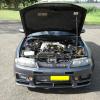Just Off The Dyno
Announcements
-
Similar Content
-
Latest Posts
-
No intention of driving the car the way it's set up now, just wanting to make sure I haven't made any mistakes along the way so that the tune can go smoothly, I don't want to waste anyone's time with stupid issues. And of course I intend to get it towed to the dyno in a completed state 😅 I have the base fuel pressure with the vacuum disconnected set at about 40psi, which I believe is at least relatively close to stock fuel pressure, maybe I'll have a fiddle with the reg and see what happens. For all I know I could be wasting my time with this and I should just plumb it in and see what the tuner reckons. I just find it a bit strange that it seems to be under so much load just free revving, but maybe that's just a result of the turbo slowing down the exhaust gasses and making a restriction in the flow, with no boost to compensate.
-
The boy just hit up google translate and it worked a treat, he said step one was "please urinate with precision and elegance", he then sent me the correct translation I get some new loctite for the small fixtures tomorrow and get some "dort" going after that 🤣
-
Right, so is the fuel pressure the same as it was previously? If not, well, it's not going to work well. I can understand the theory I assume you are going for, which is: "Run it N/A, and if I have the original AFM, and same amount of fuel and intake air as previously, the fact there's a turbo in my exhaust should still make it run" Which it... might? Provided you don't actually change how much air or fuel is going into the car.. or getting out. But if you have changed that, all bets are off. What is the purpose to even have the car run this way? To get it to a tuner? And if the goal is to limp it to a tuner, you're still going to what - plumb up a whole intercooler system and new intake in the parking lot out front before your tune......?
-
Haha yea it's a bit of a weird setup at the moment, just wanted to make sure I sorted out any headaches before dyno day. At the moment I've changed the exhaust manifold, turbo and downpipe, 460lph fuel pump and rising rate reg as well as the previously mentioned headstuds and gasket. The nistune was already mapped for the car as it was and drove around for a few months no worries. The plan is to run flex fuel hence the big pump, which I've wired direct to the battery through a relay to avoid voltage issues.
-
Um. Was the ECU the same as the one previously there? I know R33's needed R32 GTST ECU's or other tomfoolery to run Nistune. This is such a wild setup. Most people would plumb in the turbo then not drive the car (i.e tow it to a tuner). What's actually changed since it last ran?
-







Recommended Posts
Create an account or sign in to comment
You need to be a member in order to leave a comment
Create an account
Sign up for a new account in our community. It's easy!
Register a new accountSign in
Already have an account? Sign in here.
Sign In Now